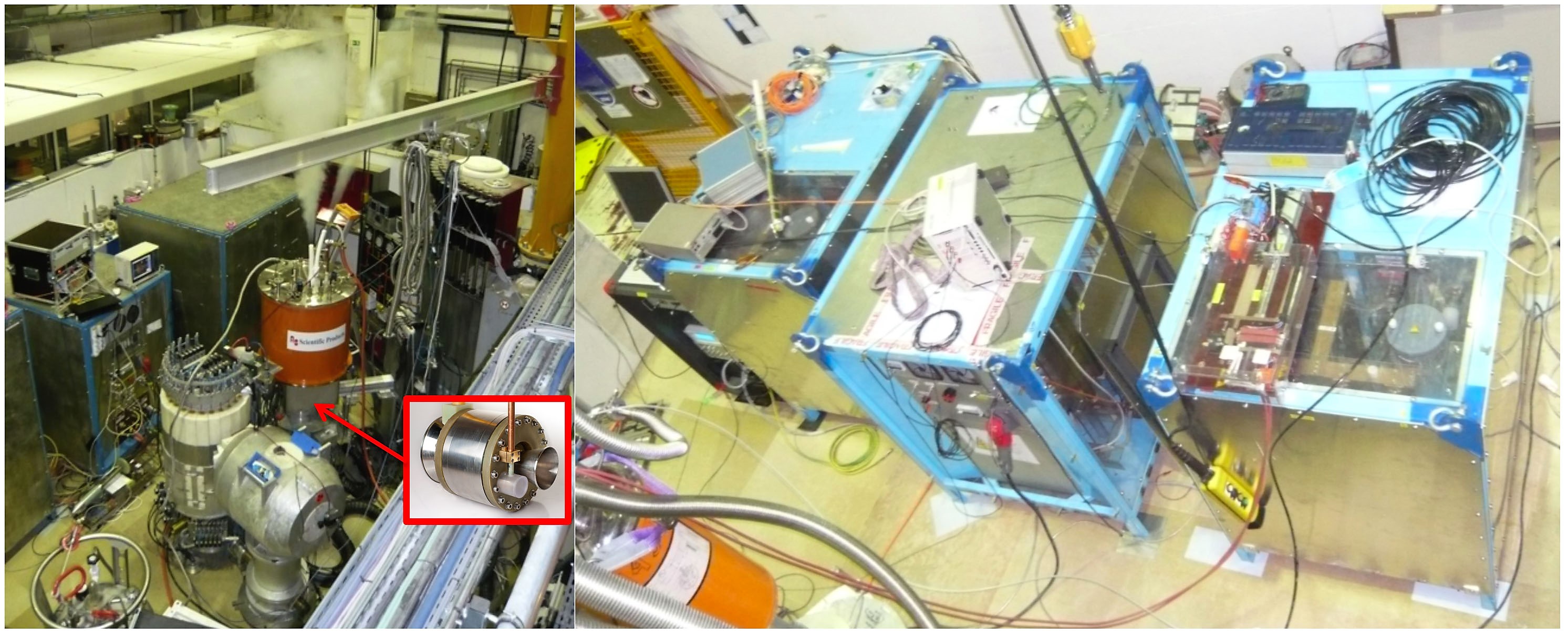IN22
CRG - Thermal neutron three-axis spectrometer with polarization analysis
Pulsed Magnetic Field
High magnetic fields for neutron diffraction
A magnetic field often induces an unexpected magnetic structure when various interactions are competing. However, only moderate dc magnetic fields are currently available for neutron diffraction, with a current limit of 26 Tesla. Recently, we upgrade the 33 Tesla portable miniature pulsed magnet with a 40 Tesla pulsed magnetic field on the world brightest steady neutron source at the ILL.
Pulsed Magnetic Field up to 40 Tesla
Magnet : 40-T conical pulsed magnet developed by the LNCMI-Toulouse, with a cryostat specially designed by the ILL-Grenoble for this magnet allowed reaching temperatures down to 2 K,
Capacitor bank: P. Frings and F. Duc (LNCMI, CNRS-Toulouse, France).
The new 40-T cryomagnet has a long-duration (total duration of 100 ms, with a rise time of 23 ms) and high duty cycle (40-T shots can be repeated every 10 min). The diffraction experiment are carried out on the triple-axis spectrometer IN22 (Collaborative Research Group-CEA at the ILL, Grenoble) operated in a double-axis or with triple-axis mode with an incident neutron wavelength going from 1Å to 1.5Å. At each momentum transfer, the field dependence of the neutron intensities is extracted by summing the data accumulated over a few pulsed-field shots, with either constant time- or constant field-integration windows (the rise and fall of the pulsed field are analyzed separately).
By using this magnet, we have succeeded in the determination of the magnet structure of URu2Si2 in magnetic field between 35 and 39 Tesla (see Fig.1 and this highlight (pdf - 3.80 Mi)).
In our pulsed magnet, a current as large as several kA is supplied by a large capacitor bank, generating a magnetic field of several tens of Tesla for more than 100 milliseconds. The total energy injected during a pulse at 40 Tesla is larger than 1 MegaJoule. It is impossible to install a large conventional capacitor bank into the limited space of neutron spectrometer.
However, the new 40T-cryomagnet, coupled with very compact mobile capacitor bank provided through the High Magnetic Field Laboratory in Toulouse enables us to use it for neutron diffraction without any modification of the spectrometer (see figure 2&3).
Examples
Applications
High field magnetic structure of the frustrated antiferromagnet TbB4
H. Nojiri, S. Yoshii and K. Ohoyama (IMR Tohoku University, Japan)
M. Matsuda (JAEA, Tokai, Japan)
S. Michimura and F. Iga (Hiroshima University, Japan)
P. Frings, F. Duc, B. Vignolle and G.L.J.A. Rikken (LNCMI, Toulouse, France)
L.-P. Regnault (INAC-SPSMS-MDN, CEA-Grenoble, France)
We examined the magnetic structure on the multiple magnetisation plateaus in the frustrated antiferromagnet TbB4 [1]. As shown in the animation (image a), the crystal forms a Shastry-Sutherland lattice, where rectangles and triangles align alternatively in a two dimensional layer.
- ground state: the Tb moments lie within the layer due to the presence of strong planar magnetic anisotropy.
- under magnetic field: several steps appear in the magnetisation process. This contradicts the well-known fact that the magnetisation of a planar antiferromagnet increases linearly with magnetic field intensity when a magnetic field is applied perpendicular to the plane.
Using the pulsed miniature magnet, we measured the time dependence of the [100] magnetic peak intensity in a sinusoidal shaped pulsed magnetic field of 7 milliseconds duration [2] up to 33 T. The data was accumulated over 100-200 shots at the rate of 10 shots/hour. It was then converted into the magnetic field dependence of the intensity as shown in the figure.
We stress here that such a non-trivial structure could be resolved only by neutron diffraction experiments in 30 Tesla fields.
This experiment demonstrates the power of miniature pulsed magnets for neutron diffraction. It also emphasises the importance of developing a high steady magnetic-field installation, which in future may enable inelastic scattering to be combined with very high magnetic fields.
The intensity exhibits multiple steps corresponding to the magnetization steps. By repeating measurements at several Bragg peaks, the magnetic structure model (animation, image b) could be determined for the half-plateau state where the magnetization is half that of the saturation. Surprisingly enough, the structure consists of a stacking of ferromagnetic and planar antiferromagnetic blocks. This shows the large contribution of the biquadratic exchange interaction causing the orthogonal arrangement between the magnetic moments.
This experiment demonstrates the power of miniature pulsed magnets for neutron diffraction. It also emphasises the importance of developing a high steady magnetic-field installation, which in future may enable inelastic scattering to be combined with very high magnetic fields.
References:
- S. Yoshii, T. Yamamoto, M. Hagiwara, S. Michimura, A. Shigekawa, F. Iga, T. Takabatake and K. Kindo, Phys. Rev. Lett. 101 (2008) 087202.
- S. Yoshii, K. Ohoyama, K. Kurosawa, H. Nojiri, M. Matsuda, P. Frings, F. Duc, B. Vignolle, G. L. J. A. Rikken, L.-P. Regnault, S. Michimura and F. Iga, Phys. Rev. Lett. 103 (2009) 077203.



 (gif - 23 Ki)
(gif - 23 Ki)